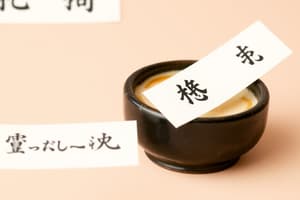Podcast
Questions and Answers
What does the term かいます refer to?
What does the term かいます refer to?
- To prepare food
- To observe scenery
- To adopt a pet (correct)
- To build on
Which phrase indicates the act of being audible?
Which phrase indicates the act of being audible?
- ひらきます
- きこえます (correct)
- みえます
- やすみをとります
What does the word だいどころ signify?
What does the word だいどころ signify?
- Outdoor
- Bathroom
- Kitchen (correct)
- Bedroom
Which option correctly describes what くうこうができます means?
Which option correctly describes what くうこうができます means?
What does the term みちをはしります mean?
What does the term みちをはしります mean?
Which word is used to describe both the concept of tools and implements?
Which word is used to describe both the concept of tools and implements?
What does the word はっきり indicate?
What does the word はっきり indicate?
Which word refers to fireworks?
Which word refers to fireworks?
What is the meaning of 'ゆめ'?
What is the meaning of 'ゆめ'?
Which term describes the act of dreaming?
Which term describes the act of dreaming?
What does 'すばらしい' mean?
What does 'すばらしい' mean?
What is the translation of 'ロボット'?
What is the translation of 'ロボット'?
What does 'ポケット' refer to?
What does 'ポケット' refer to?
Which word means 'freely'?
Which word means 'freely'?
What does 'しょうらい' refer to?
What does 'しょうらい' refer to?
What does 'たとえば' mean?
What does 'たとえば' mean?
What is the English meaning of the term 'まんが'?
What is the English meaning of the term 'まんが'?
Which term describes a character that plays a leading role in a story?
Which term describes a character that plays a leading role in a story?
What does 'じぶん' refer to in English?
What does 'じぶん' refer to in English?
What is the meaning of 'すばらしい'?
What is the meaning of 'すばらしい'?
Which of the following describes the act of 'to fly'?
Which of the following describes the act of 'to fly'?
What does 'ふしぎ' mean in English?
What does 'ふしぎ' mean in English?
How is 'いえ' translated into English?
How is 'いえ' translated into English?
What does 'あたたかい' translate to when referring to feelings?
What does 'あたたかい' translate to when referring to feelings?
What does the phrase やまがみえます indicate?
What does the phrase やまがみえます indicate?
Which of the following best describes the meaning of ひらきます?
Which of the following best describes the meaning of ひらきます?
What can the phrase おとがきこえます refer to?
What can the phrase おとがきこえます refer to?
Which of these options accurately represents じどうはんばいき?
Which of these options accurately represents じどうはんばいき?
What activity is described by やすみをとります?
What activity is described by やすみをとります?
Which term can be translated to mean the time that is after a certain duration?
Which term can be translated to mean the time that is after a certain duration?
What does the term どうぐ refer to?
What does the term どうぐ refer to?
The word けしき refers to which of the following?
The word けしき refers to which of the following?
Which phrase describes the action of taking a break or a holiday?
Which phrase describes the action of taking a break or a holiday?
What is indicated by the term that refers to a visible mountain?
What is indicated by the term that refers to a visible mountain?
Which term accurately describes the action of opening or holding a meeting?
Which term accurately describes the action of opening or holding a meeting?
What does the term まんしょん refer to?
What does the term まんしょん refer to?
Which option best describes the meaning of the phrase みちをはしります?
Which option best describes the meaning of the phrase みちをはしります?
What can be heard according to the term おとがきこえます?
What can be heard according to the term おとがきこえます?
What does the term くうこうができます imply?
What does the term くうこうができます imply?
What does the term どうぐ signify?
What does the term どうぐ signify?
What does the term 'ゆめみる' refer to?
What does the term 'ゆめみる' refer to?
Which of the following best describes 'だいすき'?
Which of the following best describes 'だいすき'?
What is the meaning of 'ふしぎ'?
What is the meaning of 'ふしぎ'?
What does 'みずあらい' specifically indicate?
What does 'みずあらい' specifically indicate?
Which term refers to the shape or figure of something?
Which term refers to the shape or figure of something?
What is indicated by the term 'しょうらい'?
What is indicated by the term 'しょうらい'?
What action does 'とびます' describe?
What action does 'とびます' describe?
Which of these options conveys the meaning of 'たとえば'?
Which of these options conveys the meaning of 'たとえば'?
Which term refers to a character that plays a leading role in a story?
Which term refers to a character that plays a leading role in a story?
What is the English meaning of the term 'ふしぎ'?
What is the English meaning of the term 'ふしぎ'?
Which word describes the action of stretching or extending something?
Which word describes the action of stretching or extending something?
What does the term 'ゆめみる' refer to?
What does the term 'ゆめみる' refer to?
Which term describes a dwelling or residence?
Which term describes a dwelling or residence?
What does the word 'だいすき' signify?
What does the word 'だいすき' signify?
Which of the following refers to a process of removing stains?
Which of the following refers to a process of removing stains?
What is indicated by the term 'しょうらい'?
What is indicated by the term 'しょうらい'?
What does the term くうこうができます imply?
What does the term くうこうができます imply?
Which phrase best describes the action indicated by ひらきます?
Which phrase best describes the action indicated by ひらきます?
What does the phrase やすみをとります refer to?
What does the phrase やすみをとります refer to?
Which option accurately conveys the meaning of みえます?
Which option accurately conveys the meaning of みえます?
What can be inferred from the term おとがきこえます?
What can be inferred from the term おとがきこえます?
The term かいます refers to which of the following actions?
The term かいます refers to which of the following actions?
What does the term たてます typically refer to in a construction context?
What does the term たてます typically refer to in a construction context?
Which phrase would suggest a visible landscape according to the terminology used?
Which phrase would suggest a visible landscape according to the terminology used?
Flashcards are hidden until you start studying
Study Notes
Japanese Vocabulary and Phrases
- かいます: To keep or raise a pet or other animal.
- たてます: To extend a building or construct additional structures.
- はしります: To run or drive.
- みちをはしります: To run or drive along a road.
- やすみをとります: To take a holiday or day off.
Observations and Sight
- みえます: To be seen or appear in sight.
- やまがみえます: A mountain can be seen.
- きこえます: To be heard or audible.
- おとがきこえます: A sound can be heard.
Infrastructure and Operations
- くうこうができます: An airport can be made or constructed.
- ひらきます: To open something or hold a meeting.
- きょうしつをひらきます: To set up a class or classroom.
Common Objects
- ペット: Pet, a common household animal.
- とり: Bird, often found in various environments.
- こえ: Voice, refers to sound made by living beings.
- なみ: Wave, used in the context of water or sound.
- はなび: Fireworks, for celebratory displays.
Nature and Environment
- けしき: Scenery or landscape, important for visual appreciation.
- ひるま: Daytime, indicating the period of daylight.
- むかし: Olden days or former times, often referring to history.
Tools and Services
- どうぐ: Tool or implement used for various tasks.
- じどうはんばいき: Vending machine, a common automated retail device.
- つうしんはんばい: Mail order sales, referring to purchasing items via mail.
- クリーニング: Dry cleaning or laundry service, essential for clothing care.
Living Spaces
- マンション: Condominium, refers to mid-rise or high-rise residential buildings.
- だいどころ: Kitchen, the area where food is prepared.
- ~ご: Indicates duration after a certain period of time.
- ~しか: Means only or nothing but, indicating limitation.
Clarity and Frequency
- はっきり: Clearly or distinctly, used for communication.
- ほとんど: Mostly or nearly, often used to describe quantities or frequency.
Hobbies and Interests
- にちようだいく: Weekend carpenter or do-it-yourselfer, indicating a hobbyist in home improvement.
- ほんだな: Bookshelf or bookcase, a common furniture item.
- ゆめ: Dream, both as aspiration and nocturnal imagery.
- ゆめみる: To have a dream, often relates to aspirations.
Temporal References
- いつか: Sometime, someday, indicating an indefinite future time.
Sentiments and Personal Affection
- すばらしい: Wonderful or magnificent, often used to express admiration.
- だいすき: Loveable or very likeable, expressing affection for something.
Narratives and Figures
- まんが: Cartoon or comic strip, a popular visual storytelling medium.
- しゅじんこう: Protagonist or hero(ine) of a story, central character in narratives.
- かたち: Form or shape, pertaining to the physical characteristics of objects.
Innovations and Mysteries
- ロボット: Robot, often associated with technology and automation.
- ふしぎ: Wonder or mystery, referring to strange phenomena.
Clothing and Fabric Care
- クリーニングや: Dry-cleaner's shop, a place for cleaning garments.
- しみぬき: Stain removal, an essential service for garment care.
- みずあらい: Washing with water without using soap, a cleaning method.
- ぼうすいかこう: Waterproof finish, a treatment for water resistance.
- ちぢみます: To shrink or contract in size.
- のびます: To stretch or extend, usually in reference to materials or fabric.
Japanese Vocabulary and Phrases
- かいます: To keep or raise a pet or other animal.
- たてます: To extend a building or construct additional structures.
- はしります: To run or drive.
- みちをはしります: To run or drive along a road.
- やすみをとります: To take a holiday or day off.
Observations and Sight
- みえます: To be seen or appear in sight.
- やまがみえます: A mountain can be seen.
- きこえます: To be heard or audible.
- おとがきこえます: A sound can be heard.
Infrastructure and Operations
- くうこうができます: An airport can be made or constructed.
- ひらきます: To open something or hold a meeting.
- きょうしつをひらきます: To set up a class or classroom.
Common Objects
- ペット: Pet, a common household animal.
- とり: Bird, often found in various environments.
- こえ: Voice, refers to sound made by living beings.
- なみ: Wave, used in the context of water or sound.
- はなび: Fireworks, for celebratory displays.
Nature and Environment
- けしき: Scenery or landscape, important for visual appreciation.
- ひるま: Daytime, indicating the period of daylight.
- むかし: Olden days or former times, often referring to history.
Tools and Services
- どうぐ: Tool or implement used for various tasks.
- じどうはんばいき: Vending machine, a common automated retail device.
- つうしんはんばい: Mail order sales, referring to purchasing items via mail.
- クリーニング: Dry cleaning or laundry service, essential for clothing care.
Living Spaces
- マンション: Condominium, refers to mid-rise or high-rise residential buildings.
- だいどころ: Kitchen, the area where food is prepared.
- ~ご: Indicates duration after a certain period of time.
- ~しか: Means only or nothing but, indicating limitation.
Clarity and Frequency
- はっきり: Clearly or distinctly, used for communication.
- ほとんど: Mostly or nearly, often used to describe quantities or frequency.
Hobbies and Interests
- にちようだいく: Weekend carpenter or do-it-yourselfer, indicating a hobbyist in home improvement.
- ほんだな: Bookshelf or bookcase, a common furniture item.
- ゆめ: Dream, both as aspiration and nocturnal imagery.
- ゆめみる: To have a dream, often relates to aspirations.
Temporal References
- いつか: Sometime, someday, indicating an indefinite future time.
Sentiments and Personal Affection
- すばらしい: Wonderful or magnificent, often used to express admiration.
- だいすき: Loveable or very likeable, expressing affection for something.
Narratives and Figures
- まんが: Cartoon or comic strip, a popular visual storytelling medium.
- しゅじんこう: Protagonist or hero(ine) of a story, central character in narratives.
- かたち: Form or shape, pertaining to the physical characteristics of objects.
Innovations and Mysteries
- ロボット: Robot, often associated with technology and automation.
- ふしぎ: Wonder or mystery, referring to strange phenomena.
Clothing and Fabric Care
- クリーニングや: Dry-cleaner's shop, a place for cleaning garments.
- しみぬき: Stain removal, an essential service for garment care.
- みずあらい: Washing with water without using soap, a cleaning method.
- ぼうすいかこう: Waterproof finish, a treatment for water resistance.
- ちぢみます: To shrink or contract in size.
- のびます: To stretch or extend, usually in reference to materials or fabric.
Japanese Vocabulary and Phrases
- かいます: To keep or raise a pet or other animal.
- たてます: To extend a building or construct additional structures.
- はしります: To run or drive.
- みちをはしります: To run or drive along a road.
- やすみをとります: To take a holiday or day off.
Observations and Sight
- みえます: To be seen or appear in sight.
- やまがみえます: A mountain can be seen.
- きこえます: To be heard or audible.
- おとがきこえます: A sound can be heard.
Infrastructure and Operations
- くうこうができます: An airport can be made or constructed.
- ひらきます: To open something or hold a meeting.
- きょうしつをひらきます: To set up a class or classroom.
Common Objects
- ペット: Pet, a common household animal.
- とり: Bird, often found in various environments.
- こえ: Voice, refers to sound made by living beings.
- なみ: Wave, used in the context of water or sound.
- はなび: Fireworks, for celebratory displays.
Nature and Environment
- けしき: Scenery or landscape, important for visual appreciation.
- ひるま: Daytime, indicating the period of daylight.
- むかし: Olden days or former times, often referring to history.
Tools and Services
- どうぐ: Tool or implement used for various tasks.
- じどうはんばいき: Vending machine, a common automated retail device.
- つうしんはんばい: Mail order sales, referring to purchasing items via mail.
- クリーニング: Dry cleaning or laundry service, essential for clothing care.
Living Spaces
- マンション: Condominium, refers to mid-rise or high-rise residential buildings.
- だいどころ: Kitchen, the area where food is prepared.
- ~ご: Indicates duration after a certain period of time.
- ~しか: Means only or nothing but, indicating limitation.
Clarity and Frequency
- はっきり: Clearly or distinctly, used for communication.
- ほとんど: Mostly or nearly, often used to describe quantities or frequency.
Hobbies and Interests
- にちようだいく: Weekend carpenter or do-it-yourselfer, indicating a hobbyist in home improvement.
- ほんだな: Bookshelf or bookcase, a common furniture item.
- ゆめ: Dream, both as aspiration and nocturnal imagery.
- ゆめみる: To have a dream, often relates to aspirations.
Temporal References
- いつか: Sometime, someday, indicating an indefinite future time.
Sentiments and Personal Affection
- すばらしい: Wonderful or magnificent, often used to express admiration.
- だいすき: Loveable or very likeable, expressing affection for something.
Narratives and Figures
- まんが: Cartoon or comic strip, a popular visual storytelling medium.
- しゅじんこう: Protagonist or hero(ine) of a story, central character in narratives.
- かたち: Form or shape, pertaining to the physical characteristics of objects.
Innovations and Mysteries
- ロボット: Robot, often associated with technology and automation.
- ふしぎ: Wonder or mystery, referring to strange phenomena.
Clothing and Fabric Care
- クリーニングや: Dry-cleaner's shop, a place for cleaning garments.
- しみぬき: Stain removal, an essential service for garment care.
- みずあらい: Washing with water without using soap, a cleaning method.
- ぼうすいかこう: Waterproof finish, a treatment for water resistance.
- ちぢみます: To shrink or contract in size.
- のびます: To stretch or extend, usually in reference to materials or fabric.
Japanese Vocabulary and Phrases
- かいます: To keep or raise a pet or other animal.
- たてます: To extend a building or construct additional structures.
- はしります: To run or drive.
- みちをはしります: To run or drive along a road.
- やすみをとります: To take a holiday or day off.
Observations and Sight
- みえます: To be seen or appear in sight.
- やまがみえます: A mountain can be seen.
- きこえます: To be heard or audible.
- おとがきこえます: A sound can be heard.
Infrastructure and Operations
- くうこうができます: An airport can be made or constructed.
- ひらきます: To open something or hold a meeting.
- きょうしつをひらきます: To set up a class or classroom.
Common Objects
- ペット: Pet, a common household animal.
- とり: Bird, often found in various environments.
- こえ: Voice, refers to sound made by living beings.
- なみ: Wave, used in the context of water or sound.
- はなび: Fireworks, for celebratory displays.
Nature and Environment
- けしき: Scenery or landscape, important for visual appreciation.
- ひるま: Daytime, indicating the period of daylight.
- むかし: Olden days or former times, often referring to history.
Tools and Services
- どうぐ: Tool or implement used for various tasks.
- じどうはんばいき: Vending machine, a common automated retail device.
- つうしんはんばい: Mail order sales, referring to purchasing items via mail.
- クリーニング: Dry cleaning or laundry service, essential for clothing care.
Living Spaces
- マンション: Condominium, refers to mid-rise or high-rise residential buildings.
- だいどころ: Kitchen, the area where food is prepared.
- ~ご: Indicates duration after a certain period of time.
- ~しか: Means only or nothing but, indicating limitation.
Clarity and Frequency
- はっきり: Clearly or distinctly, used for communication.
- ほとんど: Mostly or nearly, often used to describe quantities or frequency.
Hobbies and Interests
- にちようだいく: Weekend carpenter or do-it-yourselfer, indicating a hobbyist in home improvement.
- ほんだな: Bookshelf or bookcase, a common furniture item.
- ゆめ: Dream, both as aspiration and nocturnal imagery.
- ゆめみる: To have a dream, often relates to aspirations.
Temporal References
- いつか: Sometime, someday, indicating an indefinite future time.
Sentiments and Personal Affection
- すばらしい: Wonderful or magnificent, often used to express admiration.
- だいすき: Loveable or very likeable, expressing affection for something.
Narratives and Figures
- まんが: Cartoon or comic strip, a popular visual storytelling medium.
- しゅじんこう: Protagonist or hero(ine) of a story, central character in narratives.
- かたち: Form or shape, pertaining to the physical characteristics of objects.
Innovations and Mysteries
- ロボット: Robot, often associated with technology and automation.
- ふしぎ: Wonder or mystery, referring to strange phenomena.
Clothing and Fabric Care
- クリーニングや: Dry-cleaner's shop, a place for cleaning garments.
- しみぬき: Stain removal, an essential service for garment care.
- みずあらい: Washing with water without using soap, a cleaning method.
- ぼうすいかこう: Waterproof finish, a treatment for water resistance.
- ちぢみます: To shrink or contract in size.
- のびます: To stretch or extend, usually in reference to materials or fabric.
Studying That Suits You
Use AI to generate personalized quizzes and flashcards to suit your learning preferences.




